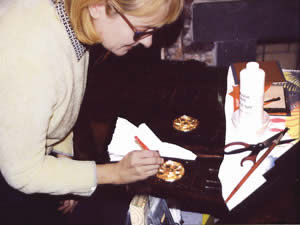
Faux Painting,
Ebonizing Wood
Real ebony has been treasured since ancient times, but using real ebony is usually not practical. Fortunately, it is easily emulated on wood moldings, furniture and other items using a variety of stain and faux techniques.
by Susan Brimo-Cox
. It adds distinction. So, too, can ebonizing.
Ebonized wood had its heyday in the late 1800s. “People who traveled to the Orient brought back ebony with gilding — and everyone wanted it,” says Cheryl Campbell, owner of Urban Revivals LLC in Washington, D.C. Ebonizing was a decorating rebellion, of sorts, and for furniture and decorative wood moldings, ebony was definitely “in.”
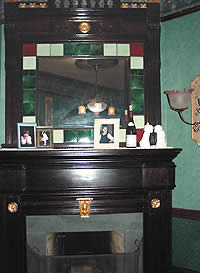 As a home accent, Campbell says, ebonizing is often associated with the furnishings of Charles Eastlake. Herter Brothers also set the standards for its use in furniture during the Renaissance Revival. But by 1905-1910, “decorating styles changed again and ebonizing fell out of favor.” As a home accent, Campbell says, ebonizing is often associated with the furnishings of Charles Eastlake. Herter Brothers also set the standards for its use in furniture during the Renaissance Revival. But by 1905-1910, “decorating styles changed again and ebonizing fell out of favor.”
Now, 100 years later, ebonizing is becoming popular again, maybe because it complements contemporary furniture styles so well. Perhaps it is because in spartan rooms with neutral color schemes it adds just the right accent. Or maybe it just adds a rich, lustrous touch that is hard to beat.
Real ebony has been treasured since ancient times, but using real ebony is usually not practical. Fortunately, it is easily emulated on wood moldings, furniture and other items using a variety of stain and faux techniques.
 “When we use the term ‘ebonizing’ for finishing or faux, we are describing a dark black-brown stain or glaze,” says Bob Levey of Bob Levey Decorative Finishing Inc. in Basalt, Colo., near Aspen. “When a designer asks for ebony, they want a brown that borders on black.” “When we use the term ‘ebonizing’ for finishing or faux, we are describing a dark black-brown stain or glaze,” says Bob Levey of Bob Levey Decorative Finishing Inc. in Basalt, Colo., near Aspen. “When a designer asks for ebony, they want a brown that borders on black.”
Other shades are often requested as well: deep browns and dark burgundies, for example.
Vic DeLor, an artist in Thousand Oaks, Calif., who has a background in the motion picture industry, points out that a painter using the right techniques can make the commonplace look expensive. “The motion picture industry relies on the faux concept rather than purchasing expensive items in most cases,” he says, “and there is no need to use expensive woods, or anything else for that matter, when the desired image can be created with paint effects. The painter must fool the camera eye with wood graining, marbleizing [and more].”
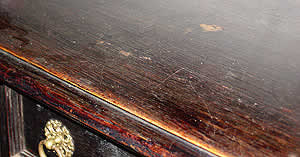
Ebonizing techniques range from extremely simple to quite complex.
The classic method of ebonizing from the late 1800s involved chemical treatments (based on copper sulfate and other chemicals) that reacted with the wood, Campbell says. “To recreate for period accuracy, this is still a technique that is used,” she says.
According to DeLor, there’s no right or wrong way. “You do whatever works for you,” he says. “Some use a black felt pen to color the smaller pieces of wood. Others prefer dyes.”
One inexpensive and time-honored method of ebonizing calls for steel wool and vinegar. (See sidebar.)
 Levey uses a two-color dye process. “I use a red alcohol dye and let that dry. Then I use a very dark walnut oil-aniline dye that won’t dissolve the red dye. Then I seal that. Then, depending on the wood, I apply a glaze of dark brown or black on top.” His final step is a lacquer finish, which could be glossy or matte. What his technique does is “give you a luminous, warm effect. It still looks dark brown to black, but it’s warm,” Levey explains. Levey uses a two-color dye process. “I use a red alcohol dye and let that dry. Then I use a very dark walnut oil-aniline dye that won’t dissolve the red dye. Then I seal that. Then, depending on the wood, I apply a glaze of dark brown or black on top.” His final step is a lacquer finish, which could be glossy or matte. What his technique does is “give you a luminous, warm effect. It still looks dark brown to black, but it’s warm,” Levey explains.
Campbell has successfully used dyes in water-based solutions, but “you have to make sure there is absolutely no prior finish.” She points out that “any residue — the slightest film — will create variations in how the color saturates into the wood.” This technique is not for novices, she says. “You can mix your dyes to exactly what you want, weak or strong. The only disadvantage is it’ll raise the grain.”
For faux applications, Levey doesn’t use dyes. Instead he uses glazes. “I’d use a ground coat, red or brown, then use oil glazes to achieve the effect I want,” he explains. To add faux wood graining, he drags a comb through it. “From there I’d seal that and add additional glazes as needed; then lacquer on top,” he says.
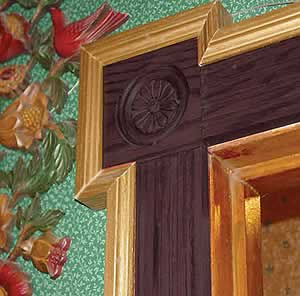
“I prefer the use of dry colors, which are the basis of most all paints and stains,” DeLor says. “Dry colors work well with alcohol or practically any other vehicle, including vinegar, as a stain, with a binder or sealer used accordingly. However, stains made with Japan colors or dark UTC (universal tinting colorant) will do the job as well.”
Campbell also uses dry pigments from time to time. She mixes them in a clear oil-based stain. But she cautions, “These pigments don’t saturate as deeply as dyes.”
Campbell also describes a Japanese lacquering technique that people use when they want a shiny dark finish but don’t want to stain the wood. By putting pigment in lacquer you don’t have to have an opaque finish; rather you can achieve a finish that is dark and shiny, but like a veil, she says. “You can control the pigment in each layer, but it is a tough technique.” This technique is usually done by machines and sprayers, she adds.
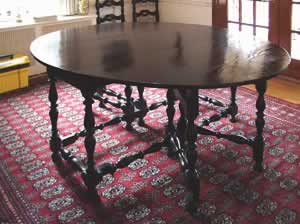
What ebonizing does best is to make something inexpensive look as if it cost a million bucks.
“You can ebonize cruddy wood and hide a multitude of sins, but when you ebonize a nicely-grained wood — when it’s stylistically appropriate — you can still see the fibers of the wood, you can still see the variations of color in the grain, and it is beautiful,” says Campbell.
You don’t want ebony to dominate a whole house, “but for accenting, side tables, pianos and such, it’s very effective,” reflects Levey.
Rich, warm and lustrous: ebonized wood. As DeLor puts it, “It’s up to the painter to make it look expensive.”

|

